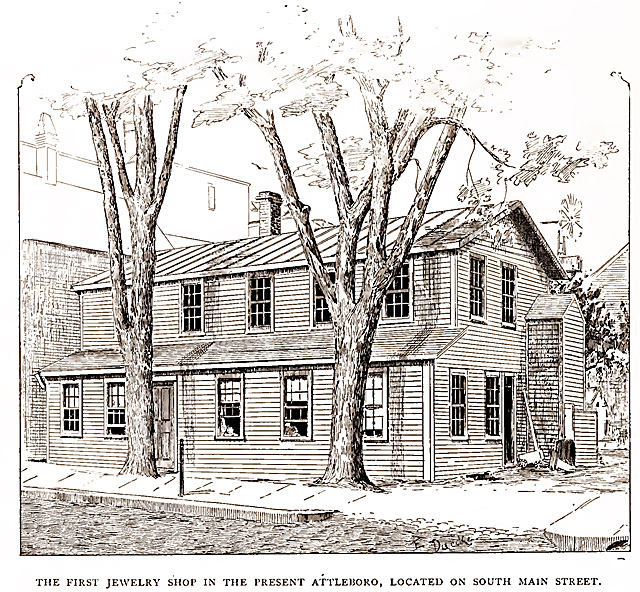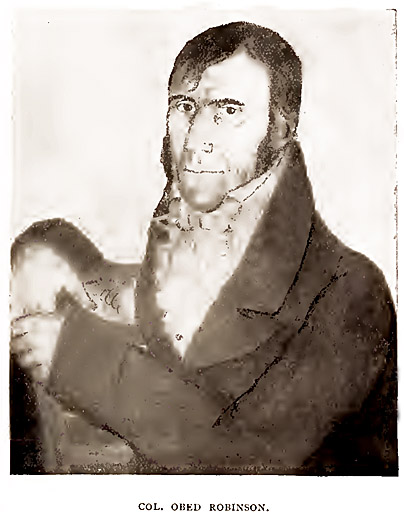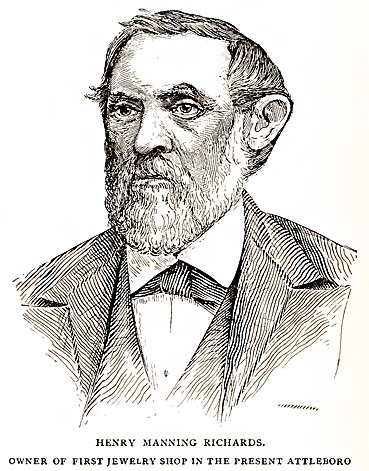quote:
ORIGIN AND DEVELOPMENT OF THE JEWELRY INDUSTRY IN ATTLEBORO
By J. ANDREW WELSHWhat is to-day the sustaining industry of the Attleboros, the industry that gives employment to thousands, in fact nine-tenths of the residents of the twin towns, and the industry which has made the name of Attleboro synonymous with jewelry, had a very humble commencement.
The first authentic instance of the manufacture of jewelry was by a Frenchman. Had this person known what trouble and trials the future residents and the historians of the town were to have, he may perhaps have been thoughtful enough to have chiseled his name on a rock or placed it in some accessible place. But he did not do so, and the name and identity of the first jewelry maker in the town which has just celebrated the 2ooth anniversary of its incorporation will perhaps ever remain a mystery.
This Frenchman settled in what is now North Attleboro, but which was the original Attleboro, in 1779. It appears that in 1780 he set up his bench in a building known as the brick shop, which was formerly a blacksmith’s forge, and was located in the vicinity of the recently destroyed Washington St. depot. His product was a sort of wire article and it had quite a sale. Suddenly this man whom the Puritanical settlers were satisfied to know as “the foreigner,” disappeared. Where he went and where he came from, careful research has failed to show.
While the manufacture of the luxury had its origin here with him, the gradual development, which led the town to be a center of the industry, was due to the Robnsons, Draper, Tifft & Co., and the Richards. There is no actual connecting link between the Frenchman’s start and any future firm. A few years after he departed, the manufacture of "carbon jewelry” was commenced by Major Robinson, at Robinsonville, a part of Falls Village. The building he occupied, it is certain, was the first structure erected in the then existing Attleboro, for the exclusive manufacture of jewelry, and it was built for that purpose alone. It is still in existence, having been remodeled, and is now used as a dwelling house, being situated near Freeman St. nearly opposite the Simmons mansion, on Commonwealth Ave. An illustration of this building is printed in this article.

At one time the claim was put forth that the Price building, which is also illustrated here, was the first shop, but it is a very easy matter to refute this statement, and prove by records in the Price family that it was the third built for the purpose. Mr. Price’s connection with the trade is referred to further on.
The success of the Robinsons is directly traceable to the manufacture of metal buttons which was commenced in 1812 by Col. Obed and Otis Robinson, and that of glass buttons, in 1813, by Richard Robinson, Willard Robinson and Virgil Blackinton, under the name of Richard Robinson & Co. Later the different persons interested in the above firms and their successors departed from the exclusive manufacture of buttons and entered other branches of the trade. This was not for years, however, as will be shown, and some samples of buttons, now exhibited in a large case at the Robinson homestead at the Falls came close to being "jewelry" in those days.
The firm of Richard Robinson & Co. was continued until 1817, from which time the business was carried on by Richard Robinson alone until 1826, when a new company was formed under the same name for a term of five years, at the end of which time another firm was organized consisting of Richard Robbinson, Wm. H. Jones, H. M. Draper and Willard Robinson. This firm was known as Robinson, Jones & Co. They commenced business in a small shop, probably about 35 X 22 feet, and the machinery was operated by the rather primitive horsepower. In 1827, this corporation which was unusually successful from the start, erected a brick factory, two stories high and 60 X 25 feet, an addition of 25 feet in length being soon after built. Horse-power had been succeeded by water power from the Ten Mile River, and the number of hands given work in this "improved factory" was in 1834, about 75, 30 of that number being females. One hundred gross of gilt buttons were being turned out daily, and in 1830 many fancy lines of goods were being made.
A writer in 1834 said; "This firm manufactured many ornamental articles for the hair, hands, etc. They have also since 1832 manufactured all varieties of navy, military, fancy and sporting buttons. This company has received all the contested premiums in New York, Philadelphia and Boston."

Of course many improvements were made in the process of manufacture, mainly of Willard Robinson’s invention, and they were patented. They all tended to the more rapid production of goods; yet the busy, hurried manufacturer of to-day may be surprised to read this extract from a paper in the possession of the family : “A common gilt button, which appears so simple when finished, undergoes in the process of being manufactured, over 30 different processes, some of which require a great deal of skill and experience, being handled over 20 times.” It appears the annual consumption of pure gold by this firm amounted at that time to $15,000.
Records, or so called records, vary considerably regarding the subsequent movements of the firm; there were occasional divisions of co-partnership, and it would seem that some of those who learned the trade and were interested in this firm moved to North Attleboro, and others to Old town or South Attleboro.
Draper, Tifft & Co. probably graduated more successful manufacturers from their shop than any other firm during the first half of this century. In the records one frequently sees the sentence, “he was an apprentice of Draper, Tifft & Co.” The firm was composed of two Drapers and Mr. Tifft. Their shop was near the old Boston turnpike and almost on the site of what is now referred to as Barden’s store. They started early in the century and remained there for years. Plain goods were their first effort and later they went on rolled plate work.
George Price was an apprentice of Draper, Tifft & Co. and the owner of the third building erected for the manufacture of jewelry. This was in 1830, and the firm occupying it was Richards & Price, the partner being Calvin Richards. The building is still in existence, and is located in what is now deemed as a decidedly out of the way place. Mr. Price later took as a partner S. L. Daggett, and they commenced the making of fire gilt jewe1ry. The firm, for years only employed six persons, yet managed to manufacture large quantities of goods. Mr. Price retired from the trade in 1856 and devoted his energies to farming. The shop was then closed.
Among the pioneers of the trade was Harvey Manning Richards, better known as Manning Richards. To him belongs the honor of opening the first shop for the sole manufacture of jewelry in the present Attleboro. This building, which is illustrated here, is located on South Main St., a short distance from the corner jewelry store of George M. Herrick. As near as can be learned it was started in 1837 or 1838.

Mr. Richards, who was born in North Attleboro in 1812, remained on the farm until the death of his father. Manning Richards, in 1826. His father added to the income of the farm by manufacturing jewelry during the Winter in a little shop, which he built near his house on the Cumberland road. Harvey M. soon after his 15th year apprenticed himself to his uncle Ira Richards, who later became a member of Draper, Tifft & Co., and manifested such an earnestness and showed such brilliancy for one so young that he was in business for himself before he reached his majority. He commenced work in 1831 in a small shop on the Boston turnpike, near the old Union house, a famous hostelry in its day, and manufactured finger rings, breast pins, guard chains, watch keys, and many smaller articles. The building was two stories high, and he rented a smaller building. His output at first amounted to about $8,000 a year. A fire interfered with his prospects, but he soon rallied and opened the South Main St. shop associating with George Morse, who looked after the manufacturing, while he went on the road as salesman.
When Mr. Richards was 21 years of age, he took for a partner E. Ira Richards, who was only 18 years of age. Fortune now smiled on the young men, and business was so prosperous that Ira Richards, the uncle to whom Harvey M. was first apprenticed, withdrew from Draper, Tifft & Co., in 1834, and associated with them under the name of Ira Richards & Co. It is said the profits of this new concern averaged $1,000 a week for the first six months.
Mr. Richards went to Boston, was unsuccessful, and in 1843 returned to North Attleboro, and with the aid of his uncle, started in the building at Plainville now occupied by Lincoln, Bacon & Co. In 1857, the panic struck him hard; he lost heavily, and in 1863 he moved to Boston and started business at 7 Green St., with his son, Eugene H. Richards. Not until 1876 did he retire from active business. Then he sold his interests to E. H. Richards & Co. July 19, 1886, Mr. Richards died at the advanced age of 74 years and eight days.
The residents of the present Attleboro, which for years was known as East Attleboro, have not been so careful in keeping record of the onward march of the trade in their town as have the residents "up north." They err largely about dates, and hardly any two persons seem to name alike the year of the commencement of a firm.
As near as can be ascertained, Joseph B. Draper and Enos Richardson started on South Main St. probably soon after Mr. Richards went there. Theirs was a two story building, and their line of work principally gold plated.
E. D. Barney opened a shop on North Main St., and the building he occupied is now in the rear of the building used for the District Court, on Main St.
James G. Bradford, an Englishman, did quite a lucrative business in the manufacture of gold pencils. He employed a few hands and was his own salesman. His chasing work was at that time considered nothing short of remarkable. “A proud, eccentric man, yet generous” is the way one who at that time was a boy describes him. Bradford died suddenly.
The first shop in the present Attleboro run by power of any kind was that of Thompson, Heywood & Lewis. This building was at what is called Mechanics’ Village, and was first used by the firm in 1850. They employed from 50 to 100 persons, as trade required. The firm later divided, each member interesting himself in some other firm. Heywood & Briggs were one firm resulting from the division.
“Attleboro cheap jewelry” is a term one hears quite frequently, and it is decidedly misapplied in the majority of cases. Perhaps historian A. T. Wales’ explanation of the origin of the term may be correct. At least, it is humorous. Mr. Wales says; “Somewhere m the fifties, perhaps a little earlier. Mason & Smith were doing business on Pleasant St. Noah Mason was the head of the firm. They made the lowest grade, in fact, the cheapest lot of goods I ever saw before or since. Why, sir, they decided one day they wanted to dissolve partnership, and when the day of settling came how do you think the jewelry was divided? By weight? Oh, no. Mason just took a common, ordinary scoop, and each one received so many scoops full of goods. And they were not so particular about getting just so much in each scoop.”
A. A. Bliss, who had been employed by several firms, opened the first shop at Farmer’s village. The building is now used as a school house.
South Attleboro, frequently called Attleboro City and Oldtown, though a small appearing place, figured quite prominently in the advance of the trade. Far back in the thirties Dennis Everett and Alfred Barrows commenced business in the basement of a house near the Four Corners. They did not continue long in this isolated place, and when the partnership was dissolved, Mr. Everett moved to a little shop on Jay St. and made chains.
Lewis Robinson and George H. Fuller were in business in what might have been called a shanty. Mr. Fuller later moved to Pawtucket.

 SMP Silver Salon Forums
SMP Silver Salon Forums

 Silver Jewelry
Silver Jewelry

 ORIGIN AND DEVELOPMENT OF THE JEWELRY INDUSTRY IN ATTLEBORO - 1894
ORIGIN AND DEVELOPMENT OF THE JEWELRY INDUSTRY IN ATTLEBORO - 1894










